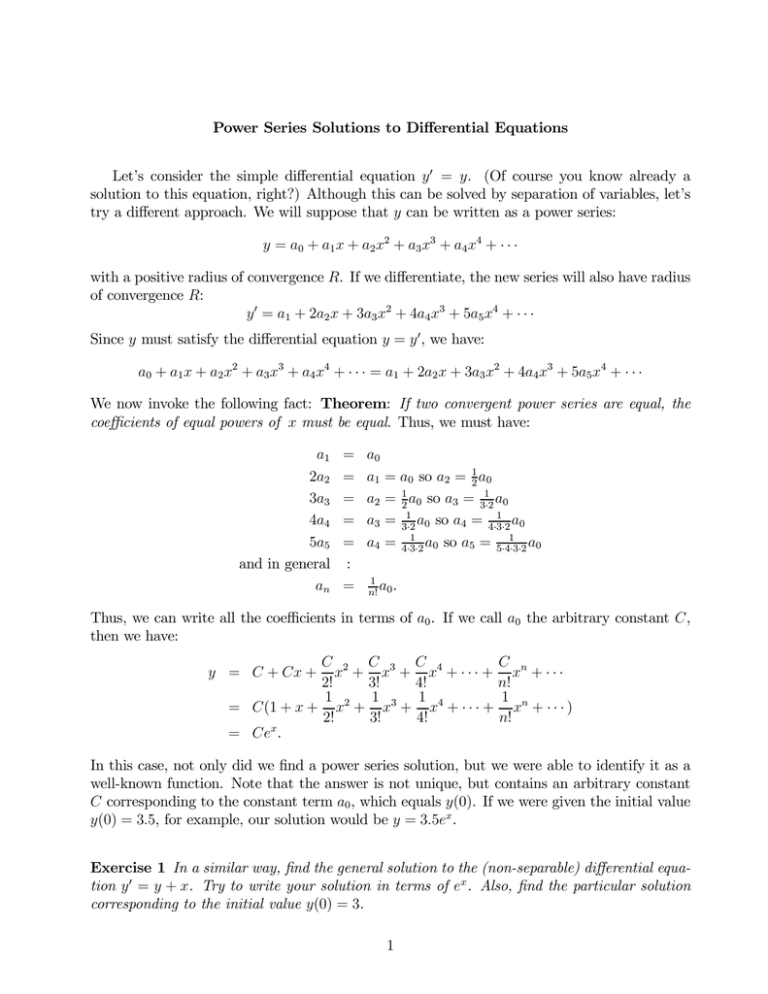Power Series Solutions to Differential Equations Let`s consider the
advertisement

Power Series Solutions to Differential Equations Let’s consider the simple differential equation y 0 = y. (Of course you know already a solution to this equation, right?) Although this can be solved by separation of variables, let’s try a different approach. We will suppose that y can be written as a power series: y = a0 + a1 x + a2 x2 + a3 x3 + a4 x4 + · · · with a positive radius of convergence R. If we differentiate, the new series will also have radius of convergence R: y 0 = a1 + 2a2 x + 3a3 x2 + 4a4 x3 + 5a5 x4 + · · · Since y must satisfy the differential equation y = y 0 , we have: a0 + a1 x + a2 x2 + a3 x3 + a4 x4 + · · · = a1 + 2a2 x + 3a3 x2 + 4a4 x3 + 5a5 x4 + · · · We now invoke the following fact: Theorem: If two convergent power series are equal, the coefficients of equal powers of x must be equal. Thus, we must have: a1 2a2 3a3 4a4 5a5 and in general an = = = = = : = a0 a1 a2 a3 a4 = a0 so a2 = 12 a0 1 = 12 a0 so a3 = 3·2 a0 1 1 = 3·2 a0 so a4 = 4·3·2 a0 1 1 = 4·3·2 a0 so a5 = 5·4·3·2 a0 1 a. n! 0 Thus, we can write all the coefficients in terms of a0 . If we call a0 the arbitrary constant C, then we have: C 2 C 3 C 4 C x + x + x + · · · + xn + · · · 2! 3! 4! n! 1 2 1 3 1 4 1 = C(1 + x + x + x + x + · · · + xn + · · · ) 2! 3! 4! n! x = Ce . y = C + Cx + In this case, not only did we find a power series solution, but we were able to identify it as a well-known function. Note that the answer is not unique, but contains an arbitrary constant C corresponding to the constant term a0 , which equals y(0). If we were given the initial value y(0) = 3.5, for example, our solution would be y = 3.5ex . Exercise 1 In a similar way, find the general solution to the (non-separable) differential equation y 0 = y + x. Try to write your solution in terms of ex . Also, find the particular solution corresponding to the initial value y(0) = 3. 1 Exercise 2 Sometimes it is too difficult to identify the function given by the power series you get when you use this technique. For the initial value problem y 0 = xy + x + 1, y(0) = 1 just find the first 5 terms of a power series solution. You can use the same technique to solve second (or higher) order differential equations. For example, consider y 00 = y: a function which equals its second derivative. As before, assume y = a0 + a1 x + a2 x2 + a3 x3 + a4 x4 + · · · so 00 y = 2a2 + 3 · 2a3 x + 4 · 3a4 x2 + 5 · 4a5 x3 + 6 · 5a6 x4 + · · · This gives the equations: a0 a1 a2 a3 a4 a5 = = = = = = anything, say C anything, say D 1 a = 12 C 2 0 1 1 a = 3·2 D 3·2 1 1 1 a = 4·3·2 C 4·3 2 1 1 a = 5·4·3·2 D 5·4 3 etc. This gives us the series: 1 1 1 1 y = C + Dx + 12 Cx2 + 3·2 Dx3 + 4·3·2 Cx4 + 5·4·3·2 Dx5 + 6·5·4·3·2 Cx6 + · · · = C(1 + 2!1 x2 + 4!1 x4 + 6!1 x6 + · · · ) + D(x + 3!1 x3 + 5!1 x5 + · · · ) where C and D are arbitrary constants – they are determined once we know initial values y(0) and y 0 (0). Exercise 3 The hyperbolic sine and cosine, denoted sinh and cosh, are defined as follows: ex − e−x 2 ex + e−x cosh(x) = 2 sinh(x) = Use the computation just made to show that the general solution to y 00 = y is y = A sinh(x) + B cosh(x). You’ll need to find power series for sinh and cosh, which you get easily from the series for ex and e−x (put −x for x in the series for ex ). Note that A = 2C and B = 2D. Suppose y(0) = K and y 0 (0) = L; what will A and B equal? Exercise 4 Repeat what was just done, except for the differential equation y 00 = −y: show that the general solution is y = A sin(x) + B cos(x). If y(0) = K and y 0 (0) = L, what will A and B equal? 2





